| Spartan 3E organ project | |||||||||||||||||||||||||||||||||||||||||||||||||||||||||||||||||||||||||||||||||||||||||||||||||||||||||||||||||||||||||||||||||||||||||||||||||||||||||||||||||||||||||||||||||||||||||||||||||||||||||||||||||||||
| 12 oscillators 6 Sub-Modules 88 voices 127 midi channels 384 kHz Audio DSP |
Spartan 3E Virtual Analog Organ - V07 . This site describes my latest fully programmable virtual organ project. You are encouraged to download the programming file and test the songs yourself. To fully get informed about the functions please also read the pages about the former versions: Virtual Analog Organ V03 - an emulation of my analog organ from 2003 Virtual Analog Organ V01 - an emulation of my analog organ from 2001 Intention The idea behind the project was to reveal the former project and also the sound without recreating or rebuilding the analog hardware. To be honest the concept of my analog organs to create parallel PCBs and sound channels for all possible tones and layers leads to much work. With nowaday's FPGA most of that can be done by copy and paste actions. Also certain enhancements can be done easily like stereo placing and effects. Over the years the sound quality progressed like shown in the following table:
Platform Xilinx Spartan Starter Kit 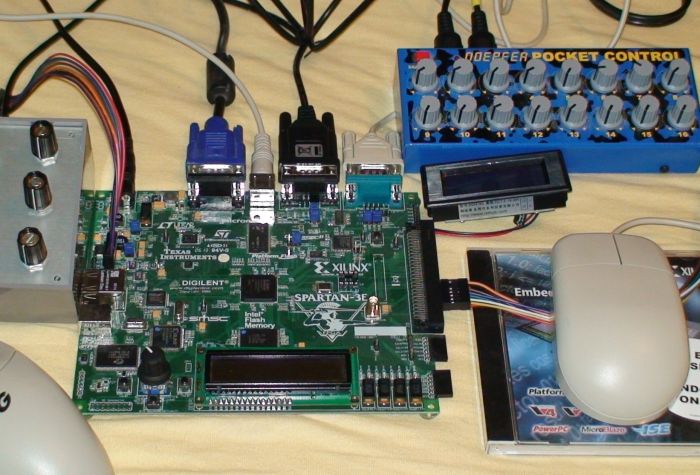 A Spartan 3E FPGA board is used to realize the organ project. All components are made the digital way meaning, that they are virtually modeled. The main components for sound generation are basically the same as in the first anlog version from 2001 - but all the analog components were replaced. The keyboard is virtually modeled and has been replaced by a simplified MIDI-box being capable to play up to 65535 music notes sequentially. 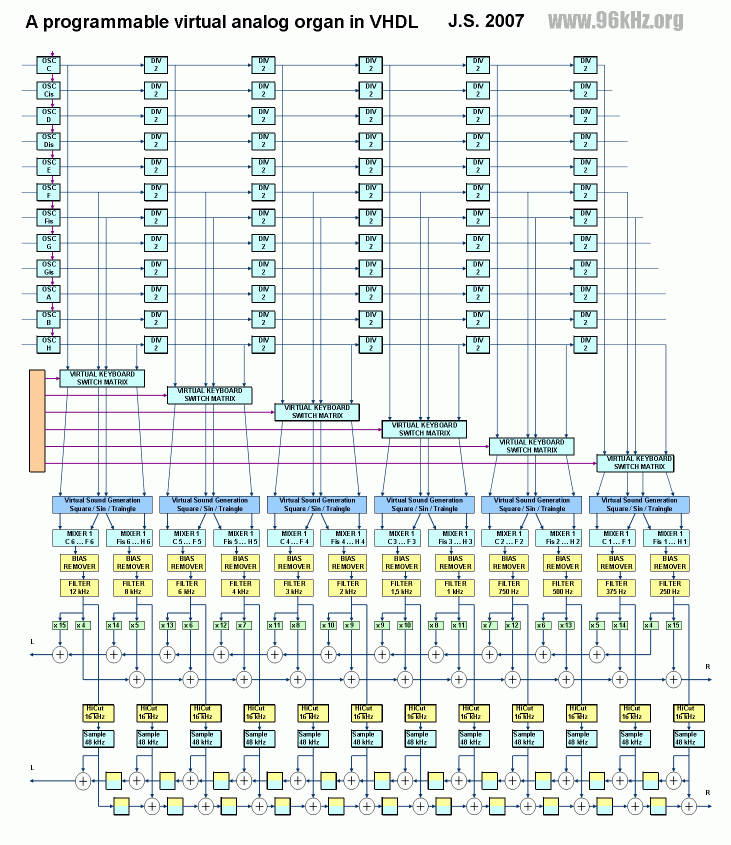 Music Box / MIDI Engine The Music Engine produces MIDI-like tone information, based on pre defined tone information which is kept in a local memory in the FPGA. The notes are initially copied to the RAM during synthesis process of the FPGA. 127 MIDI notes are available, where 60 keys (5 octaves) are used. The data entry is done with the classical piano roll method using an Microsoft Excel sheet which automatically generates the code for the FPGA music player.  Music entry is easy this way because for an organ, there is only on off required. The length of the lines = the cells covered indicate the time which the sound has to be applied. A second sheet analyzes the lines and eventually creates on off tags from it which are text-summarized in the last column finally. 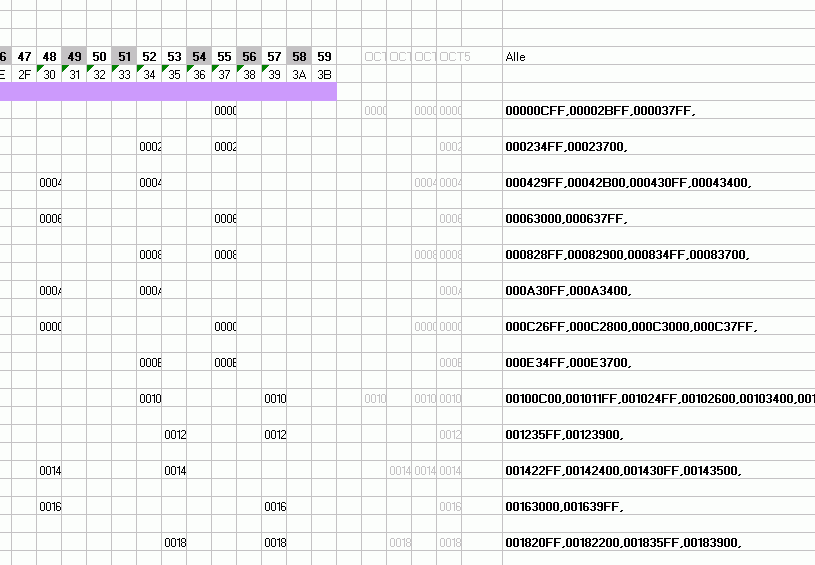 The code in the final column is used as a so called COE-file and will be loaded into the Block-RAM of the Xilinx FPGA during the compilation process. The data format is TTTT.NN.II "point of time", "note number", "intensity" where 0 means "off". 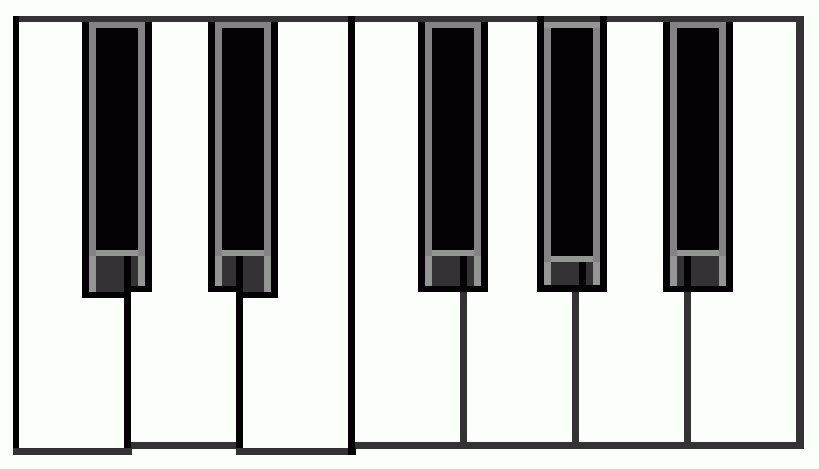 Visualization of "pressed keys" of the virtual keyboard Synthesis Engine The sound synthesizer takes the music notes and produces audio signals for each midi channel using the virtual wave module and synthesis module described in the organ project. 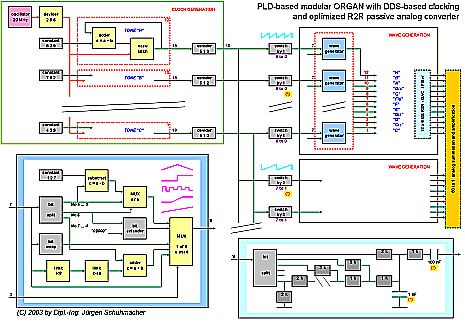 DSP Engine The sound synthesizer takes the music notes and produces audio signals for each midi channel using the virtual wave module and synthesis module described in the organ project. Limitations Because of the limited space in the little Spartan 3 FPGA, some restrictions do apply: - only simplified sine wave is possible next to triangle - only 2 organ register are implemented so far - no "analog" distorted R2R behavior - no analog filtering / de-BIAS-ing is done - PDM output is used instead of S/PDIF - no music keyboard control - no high speed MIDI - only 8192 MIDI notes possible Enhancements - balanced and pure tuning is available now digital pre filtering is applied to emulate the former analog conversion circuit - digital analog noise is introduced to smooth calculation and emulate analog noise - analog boost is applied using amp modeling to emulate non linearity - automatic music player included to emulate keyboard - stereo virtual processing using static 3D placing and reverb Downloads Download the programming files for S3E: vpldorgan07 |
||||||||||||||||||||||||||||||||||||||||||||||||||||||||||||||||||||||||||||||||||||||||||||||||||||||||||||||||||||||||||||||||||||||||||||||||||||||||||||||||||||||||||||||||||||||||||||||||||||||||||||||||||||
|
|
|||||||||||||||||||||||||||||||||||||||||||||||||||||||||||||||||||||||||||||||||||||||||||||||||||||||||||||||||||||||||||||||||||||||||||||||||||||||||||||||||||||||||||||||||||||||||||||||||||||||||||||||||||||
© Jürgen Schuhmacher 2007